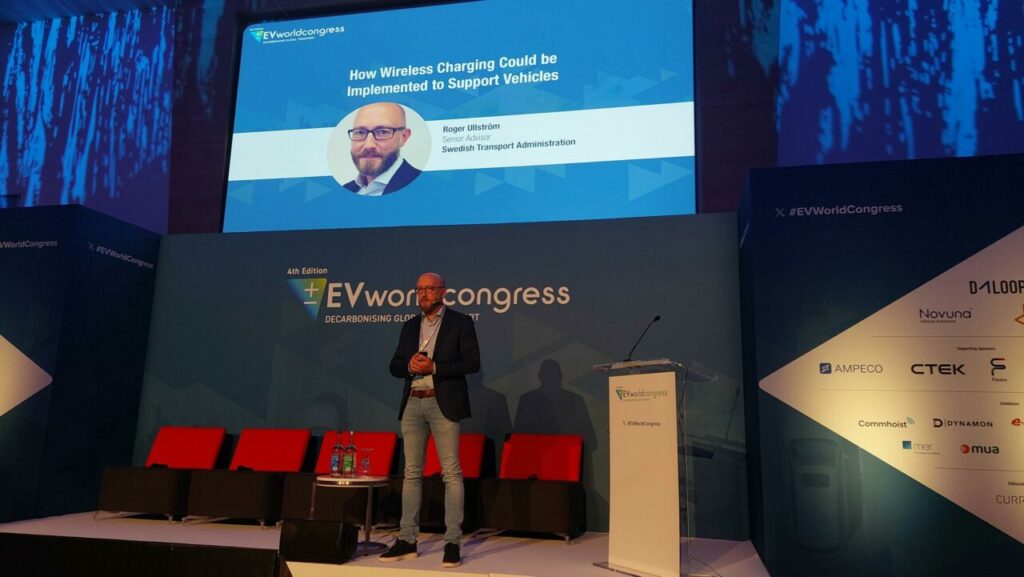Today (11 October) is the second day of Solar Media’s EV World Congress 2023 (EVWC23) at the Novotel London West, bringing together the best and brightest from the emobility sector for a series of panels and presentations.
Current± will be covering the biggest stories direct from the event over its two days, bringing you all the insight, news, and views from the conference.
Accessible information, not battery degradation hinders the used EV market, EVWC hears

“There’s an education piece we need to do about EV finance, it’s not about getting into debt, but more like a subscription that you would have for platforms like Netflix,” said Lauren Pamma, managing director at the Green Finance Institute during this morning’s ‘Navigating the Second-Hand EV Market’ panel.
Agreeing with her fellow panelist that a “£500 second-hand EV banger” many never be viable – due to the battery always being more valuable for a recycler or for energy storage – more drivers could be tempted and able to purchase second-hand EVs if they were better informed around financing to support with EV costs – both upfront and maintenance.
Fellow panelist, Marc Palmer, head of strategy and insight at Auto Trader, made the point that, from the company’s data, 18 to 34 year-olds often don’t see financing as debt but worry about whether they will be accepted. Whereas, drivers in an older age bracket are concerned at the prospect.
“People that have the money don’t trust the product and don’t like using finance,” said Palmer.
Adbul Chowdhury, head of vehicle policy, at the Office for Zero Emission Vehicles (OZEV), told the audience four key areas the UK government is currently addressing to help bolster the UK used EV market:
- Confidence around battery health
- Lack of consumer information (early adopters versus mass transition)
- Skills – dealerships and forecourts as well as EV technicians
- Affordability – upfront cost as well as ownership
On the topic of battery degradation, each panelist agreed that the issue was not as detrimental to drivers as has often been portrayed.
Pamma, made the point that her three-year-old, recently acquired EV has a better battery than the same model she purchased new a few years ago as battery maintenance has improved during this period.
Chowdhury added: “EV battery’s have a 2% per year degradations, so the average vehicle lifespan is 10-15 years and the used EV price will reflect this.”
Chowdhury also noted that the recently released ZEV Mandate included content on battery health warrantees, requiring battery providers to provide warrantees after 8 years of 100,000 miles.
“Battery health is not a problem, but we need to decide how to say this [to consumers] as we can’t have a car-by-car basis,” said Palmer.
Auto Trader is in the process of putting together a battery health guide for EVs to help guide people on what the battery performance range of EVs of various ages/mileages will be to help provide confidence in the used EV market.
EVWC explores the potential of dynamic charging

“To get an electric road to work you need electricity, you need an electricity grid, and you also need an electricity grid along the road, this is the big difference between static charging and dynamic charging,” Roger Ullström senior advisor from the Swedish Transport Administration told the EVWC23 audience this afternoon.
“You will also need substations and management units along the road, depending on which technology you choose,” Ullström added.
Discussing how dynamic charging could be implemented to support vehicles, Ullström took the audience through four dynamic charging demonstration projects in Sweden from 2016 onwards.
Sandbiken
Having started in 2016, this features the same technology as trains, including two wires, catenary lines above roads, with one positive and the other minus. Although a proven technology, Ullström noted that this infrastructure can not measure the energy each vehicle uses for charging and is only suitable for large load vehicles.
Arlanda
This technology is similar to that of electric cars sold in toy shops. With metal infrastructure built into roads as a receiver dangles from the bottom of the vehicle. The metal infrastructure can transfer 900kW when driving and this technology is suitable for both cars and trucks.
The receivers are fitted with an upward slanted mental case that clears the track from any rocks and debris that were previously blocking the track.
Lund
This features submerged infrastructure – one meter positive, one meter negative – that can measure energy on each vehicle passing the road and can also communicate with vehicles if there are problems on the road ahead.
Installation of this technology is also relatively simple, as all the tech is imbedded within the road so no additional infrastructure is required.
ElectronReeon – wireless electric roads
ElectronReeon created one of the most recent demonstration projects for dynamic charging in Sweden, which feature copper coils (around 4cm in thickness) installed underneath the road surface to transfer energy to receivers within the vehicle – this means the roads look the same as their non-electric counterparts.
With the vehicle and management system installed above ground, cars are able to drive and charge at the same time.
Italy, Austria and Denmark have already joined forces with Sweden to learn more about what the future of electric roads and dynamic charging could look like in Sweden, Ullström concluded.
‘Drivers pick destinations based on EV charging offerings,’ says Shell Recharge

“Our research shows that EV drivers choose locations and places to go based on the charging offering that is there,” said Nicholas Parkes, head of destination EV Europe at Shell Recharge this afternoon at EV World Congress.
Speaking on the ‘Is Destination Charging the Missing Piece in a Nationwide Charging Network?’ panel discussion, Parkes highlighted how the use of efficient EV chargers at destinations could be a revelation for businesses – particularly shops.
“Drivers will also spend more in the shops too – there’s a real opportunity to attract people to the sites through EV charging,” Parkes added.
This could incentivise the installation of EV chargers at several destinations such as hotels, shops, universities and more. However, there is a need to create a “seamless experience” for drivers to charge their EVs, Parkes noted.
Part of this seamless experience includes ensuring that the right type of EV infrastructure or charger is in place to cater to the specific destination. For example, a destination that customers are expected to spend several hours at, could benefit from a slow charger, whereas destinations with shorter stops should look at rapid charging solutions.
Fellow panellist, Diogo Freitas, lead solutions engineer at Daloop, added: “The infrastructure you put in place must match the destination that you are. It must also cater for the time taken at places.
“Relying on high-speed hubs will cause issues as the costs will be very high for charging.”
This is where destination chargers with slow charging solutions could be a revelation for the market, presenting a cost-effective method for EV drivers to recharge.





